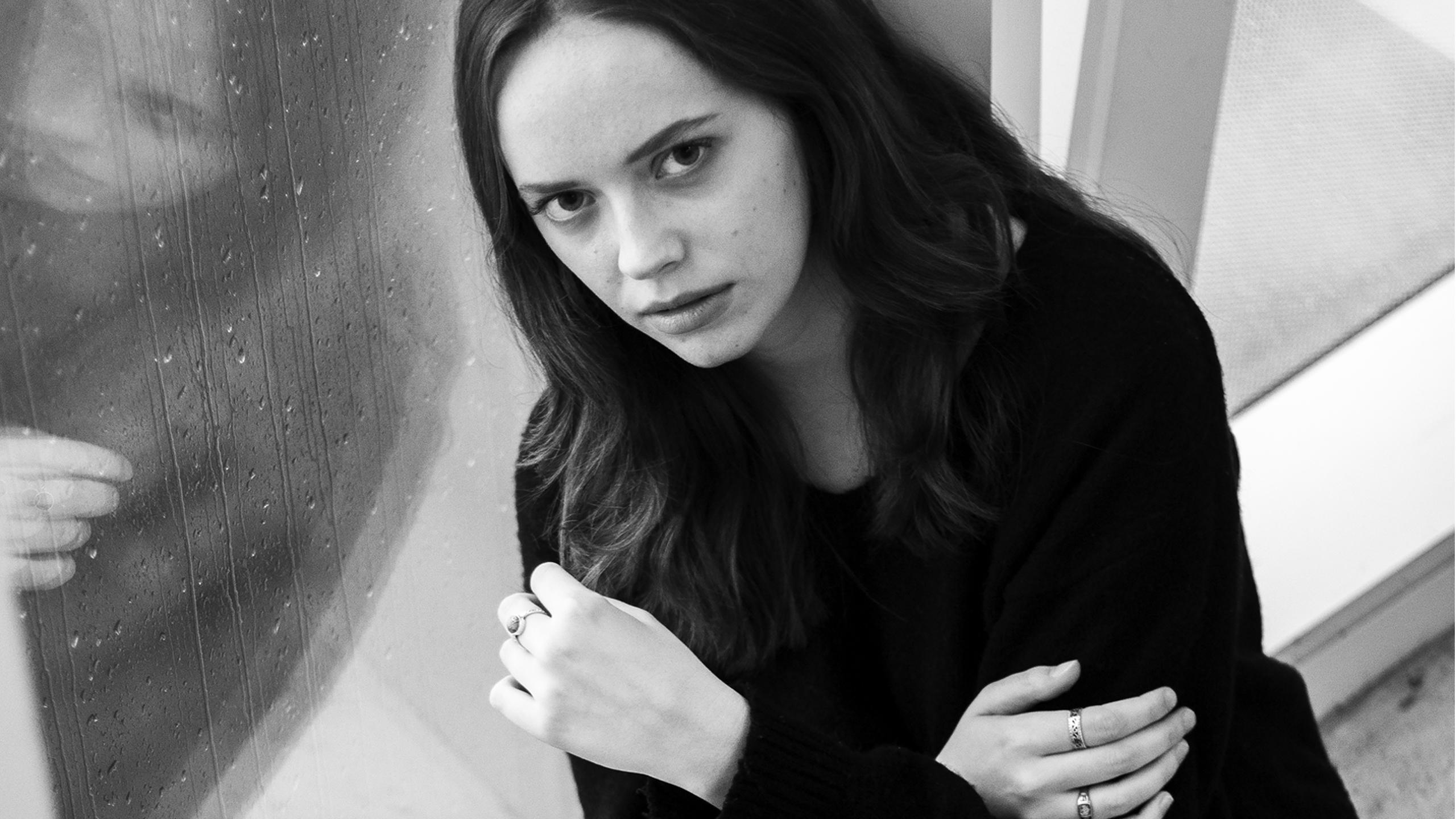By Katrina McGaughey
Content warning: This article contains brief mentions of sexual harassment and eating disorders.
I was eight years old the first time I walked in a fashion show for my mom’s atelier boutique. My 12-year-old sister held my hand as we walked down the runway together. I smiled at the sound of someone sitting front row, saying, “those must be the designer’s daughters.” Clutching a bouquet of flowers, the thrill made me forget the fear and doubt.
I used to spend my days after school with my mother at her studio, enthralled by everything she did. I watched her sketch designs and her seamstress sewed long dresses. I’d stare at the rainbow-coloured wall of thread and ribbon, flipping through old issues of Vogue for hours. The world of fashion was so exciting to me.
I had no idea that 10 years later, walking down runways would just be another part of my job.
“How tall are you?” was the first question the modelling scout asked me, as I stood beside my dad outside an H&M in downtown Montreal. I was 14 years old and at the height of my insecurities. My dad had a suspicious look on his face as he politely chatted with the woman. “She definitely has an international look,” she said, eyeing me up and down.
With every word she said, my dad became more protective as I became more intrigued. I felt like I had a shot in an industry that I had only known as my mother’s.
When we got home, I ran to my mom in the living room. “I’m going to be a model!” My dad handed her a shiny business card.
“We can discuss this in a few years,” she said softly, placing the card in the front pocket of her green Cole Haan purse. I didn’t understand—why would someone who’s made a successful career in the industry want to keep her daughter from it?
I was scouted twice more as a teenager until age 16 when my mom said I was old enough to join the industry. I was just short of graduating high school, with a confidence I didn’t have before.
Less than a year later, my mom and I sat at a long wooden table directly across the owner of a boutique modelling agency. She took out a fancy pen and slid a neat pile of stapled paper toward me. I signed my name on the dotted line of the page. “We’re happy to represent you, Katrina,” she said, with a trusting smile.
It’s taken my entire career to understand my mom’s hesitation. I didn’t have the capacity to handle what’s expected of young girls in the fashion industry. I was one of the lucky ones—I only stressed in high school over class and friends.
After almost three years of moderate success in my hometown, I decided to pack up and move to Toronto to study theatre at Ryerson, where I signed with a new agency.
You’re serious about having a career as a model, right?” a makeup artist asked as she touched up my over-the-top red lips. A photographer had just asked me to take my top off for the next set of photos. I was 17. I told them my agent didn’t want me posing topless while I was still underage.
As we continued the uncomfortable photoshoot, the makeup artist persisted. “You know every big model has posed topless,” she said, as though I had never opened a fashion magazine before. “You’re going to have to start getting comfortable with taking your clothes off in front of strangers.” I nodded and kept quiet, knowing that if I fought back, my agent would get an email saying something like, “model difficult to work with.”
After five years of this treatment, I developed an eating disorder. I became emotionally detached from my job and personal life. I dreaded having a tape measure wrapped around my body. I still flinch anytime someone touches my hips, waist or chest.
“You’re going to have to get comfortable taking your clothes off in front of strangers”
I also found myself dealing with imposter syndrome. Long commutes to and from castings had me constantly thinking about how my agency must have signed me by mistake.
My career is one that depends on what a casting director deems pretty that day. Sometimes I hear the voices of photographers and makeup artists I’ve worked with, telling me I’m not as toned or easy to shoot as other models. Their words play on a loop until I find a pen and paper to do some mindful journaling.
It’s normal to be told I won’t book a job until I lose a few centimetres off my hips. It’s normal not to know when I’ll get my next paycheque. It’s normal to have a photographer’s hand linger on my back for a few seconds longer than is required to unzip a dress. Things that would have shocked me when I first entered the industry are now just a given part of the job.
North American modelling agencies are considered management companies, hiring models as independent contractors and receiving a part of their commission—usually 20 per cent.
Being independent means models can be flexible, but they don’t get benefits contracted employees do—similar to any freelancer.
A study released by The Model Alliance, a New York-based model advocacy not-for-profit organization, reported in 2012 that 86.8 per cent of models have been asked to pose nude at a job or casting without advance notice, of which 27.5 per cent ended up posing nude because they felt they had to, even though they didn’t want to. In addition, 76.5 per cent reported they’ve been exposed to drugs and/or alcohol on set and 68.3 per cent suffer from anxiety and/or depression.
Models pay for their own insurance, handle their own taxes and don’t have a place to report workplace sexual harassment. We’re also not unionized, so there’s no one to represent us when we face issues with agents or feel wronged. The Model Alliance reported only 29.1 per cent of models who have been sexually harassed at work felt they could tell their agency. Two-thirds found their agents didn’t see a problem.
According to Ben Barry, Ryerson’s chair of fashion, who launched his own agency at age 14, agencies will cover costs for comp cards, portfolios, clothing, travel, and accommodations, just to deduct the cost from the model’s pay when they book jobs. Contracts are sometimes written in complicated language, making it hard to understand what you’re signing. According to the U.S. Bureau of Labor, the median amount a model makes in a year is $22,900. Resources for models in Canada are scarce as the market isn’t as big as cities like New York or Paris.
“Models often owe their agencies a significant amount of money. It can take several high-paying jobs to pay off their debt—provided the model even books those jobs,” said Barry.
After signing my first-ever contract, my agent told me, “You are going to make so much money one day.” I nodded in excitement. I was young and never had a real job, so I trusted my agency to keep the promises they made. I didn’t know how much money I’d have to spend before making any myself.
As a new face, I was often told that the photographs used in my portfolio were enough compensation for my time. Not being paid in money is common for models—we’re offered designer clothing, party invitations and social media exposure—as if a few more Instagram followers will pay my rent and tuition.
But change is slowly coming to the industry. In 2013, New York state passed a law that extends the protections given to underage models. Since 2017, France has required models to show clients a certificate that confirms their physical well-being and states that they’re not underweight. Most recently, the Model Alliance’s 2018 Respect Program asked companies to sign a legal document promising to take action if a complaint is filed, aiming to prevent sexual abuse in the modelling industry.
In Canada, however, legal changes have yet to take place.
Modelling isn’t just glam and flashing lights. That notion is partially what allows this abuse against young people in fashion to continue. While it’s our job to be seen, not heard, we need to keep being vocal about the harmful realities of the industry.
This past Christmas, I sat with my mom in her closet looking through old jewelry and purses. I picked up a green purse I thought might look cute with my outfit that night. “Oh, that’s a special one,” she said, gesturing for me to open its pockets.
As I opened it, a card fell out; the one from the first agent to ever scout me. Holding it, years later, made me relieved and sad. I thought she’d thrown it out, which, for a moment, re-sparked my teenage resentment.
Reading the name of an agent I never saw again reminded me why I’m still modelling, despite the fact that I’ll probably never make it to the top. I know that if I quit tomorrow, there’s a 16-year-old girl ready to take my place.











V
I enjoyed reading this. Thank you for sharing your experience!
Gerry Hionis
Wonderful article!
I hope that the industry will turn for the better soon.
T
I never thought about it that way. You’re really strong. Thanks for sharing this
Bill J. from Austin
The music industry has many of the same pitfalls: predatory practices, confounding contracts, body shaming, sexual harassment, easy access to drugs….. The history of popular music is littered with the shattered hopes of young songwriters who were tricked or bullied into signing away songs that later made someone ELSE tremendously wealthy. Young performers trying to prove they ‘have what it takes’ to reach stardom end up used, abused and discarded. Some practitioners are no better than bus depot pimps, snatching up the hopefuls before they have a chance to comprehend what’s being done to them.
Note that even with an industry-savvy parent’s guidance, Ms. McGaughey fell victim to some of the familiar tropes and traps. Now imagine what her life might have become if she HADN’T had her parents’ guidance and protection.
I’m glad the author has survived, and I hope her’s and others’ efforts to change the future for young models may come to fruition.